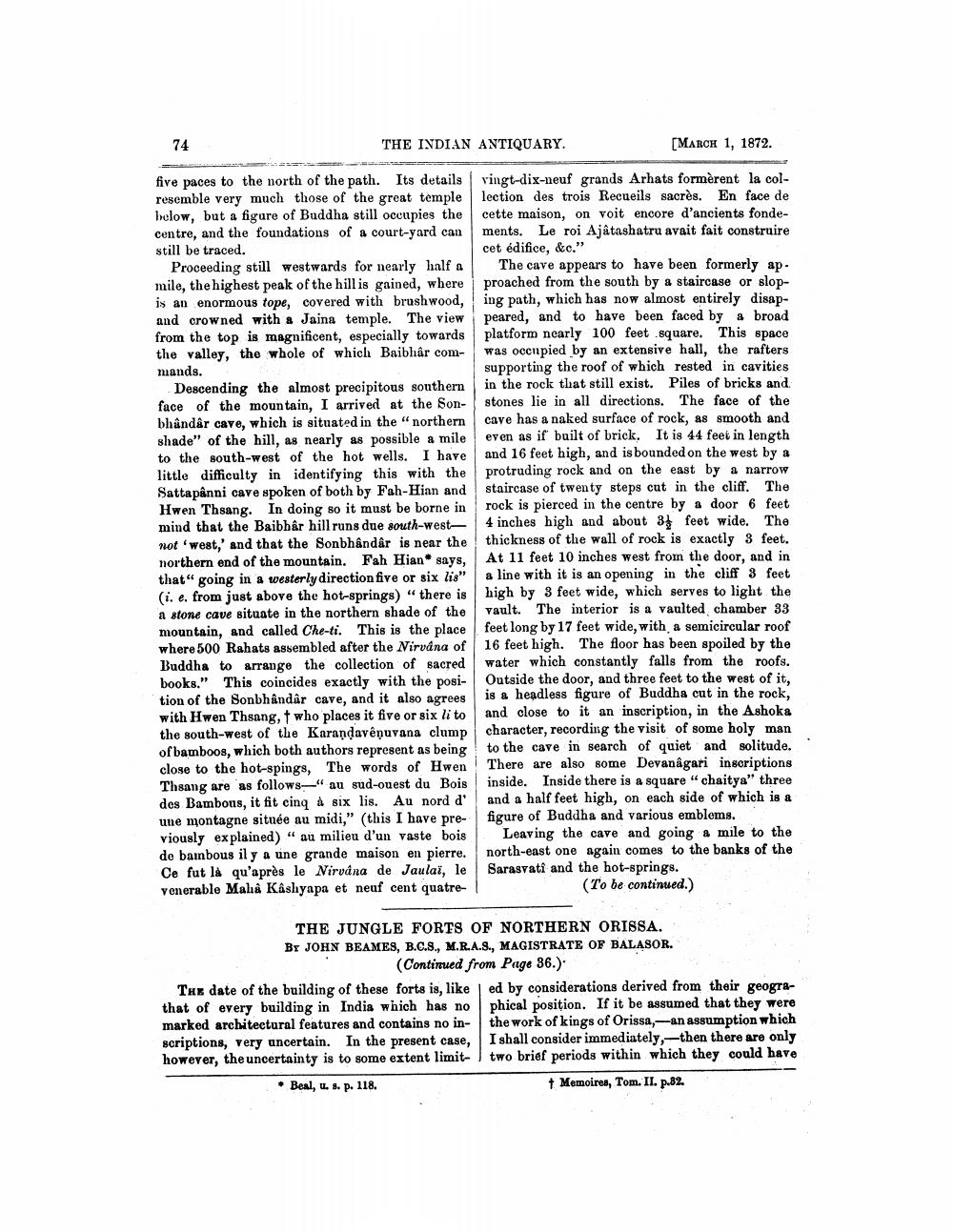________________
74
THE INDIAN ANTIQUARY.
five paces to the north of the path. Its details resemble very much those of the great temple below, but a figure of Buddha still occupies the centre, and the foundations of a court-yard can still be traced.
Proceeding still westwards for nearly half a mile, the highest peak of the hill is gained, where is an enormous tope, covered with brushwood, and crowned with a Jaina temple. The view from the top is magnificent, especially towards the valley, the whole of which Baibhâr commands.
Descending the almost precipitous southern face of the mountain, I arrived at the Sonbhandar cave, which is situated in the "northern shade" of the hill, as nearly as possible a mile to the south-west of the hot wells. I have little difficulty in identifying this with the Sattapânni cave spoken of both by Fah-Hian and Hwen Thsang. In doing so it must be borne in mind that the Baibhâr hill runs due south-westnot 'west,' and that the Sonbhândâr is near the northern end of the mountain. Fah Hian says, that" going in a westerly direction five or six lis" (i. e. from just above the hot-springs) "there is a stone cave situate in the northern shade of the mountain, and called Che-ti. This is the place where 500 Rahats assembled after the Nirvana of Buddha to arrange the collection of sacred books." This coincides exactly with the position of the Sonbhândâr cave, and it also agrees with Hwen Thsang, † who places it five or six li to the south-west of the Karandavênuvana clump of bamboos, which both authors represent as being close to the hot-spings, The words of Hwen Thsang are as follows" au sud-ouest du Bois des Bambous, it fit cinq à six lis. Au nord d' une montagne située au midi," (this I have previously explained)" au milieu d'un vaste bois de bambous il y a une grande maison en pierre. Ce fut là qu'après le Nirvana de Jaulai, le venerable Malia Kashyapa et neuf cent quatre
[MARCH 1, 1872.
vingt-dix-neuf grands Arhats formèrent la collection des trois Recueils sacrès. En face de cette maison, on voit encore d'ancients fondements. Le roi Ajâtashatru avait fait construire cet édifice, &c."
THE date of the building of these forts is, like that of every building in India which has no marked architectural features and contains no inscriptions, very uncertain. In the present case, however, the uncertainty is to some extent limitBeal, u. s. p. 118.
The cave appears to have been formerly ap proached from the south by a staircase or sloping path, which has now almost entirely disappeared, and to have been faced by a broad platform nearly 100 feet square. This space was occupied by an extensive hall, the rafters supporting the roof of which rested in cavities in the rock that still exist. Piles of bricks and stones lie in all directions. The face of the cave has a naked surface of rock, as smooth and even as if built of brick. It is 44 feet in length and 16 feet high, and is bounded on the west by a protruding rock and on the east by a narrow staircase of twenty steps cut in the cliff. The rock is pierced in the centre by a door 6 feet 4 inches high and about 3 feet wide. The thickness of the wall of rock is exactly 3 feet. At 11 feet 10 inches west from the door, and in a line with it is an opening in the cliff 3 feet high by 3 feet wide, which serves to light the vault. The interior is a vaulted chamber 33 feet long by 17 feet wide, with, a semicircular roof 16 feet high. The floor has been spoiled by the water which constantly falls from the roofs. Outside the door, and three feet to the west of it, is a headless figure of Buddha cut in the rock, and close to it an inscription, in the Ashoka character, recording the visit of some holy man to the cave in search of quiet and solitude. There are also some Devanagari inscriptions inside. Inside there is a square "chaitya" three and a half feet high, on each side of which is a figure of Buddha and various emblems.
Leaving the cave and going a mile to the north-east one again comes to the banks of the Sarasvati and the hot-springs. (To be continued.)
THE JUNGLE FORTS OF NORTHERN ORISSA. BY JOHN BEAMES, B.C.S., M.R.A.S., MAGISTRATE OF BALASOR. (Continued from Page 36.).
ed by considerations derived from their geographical position. If it be assumed that they were the work of kings of Orissa,-an assumption which I shall consider immediately, then there are only two brief periods within which they could have
† Memoires, Tom. II. p.82.




